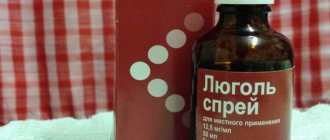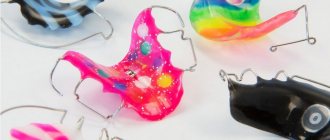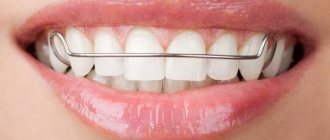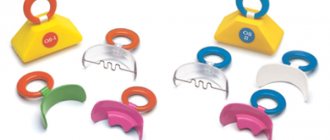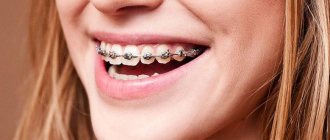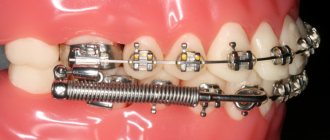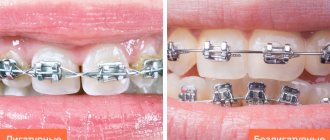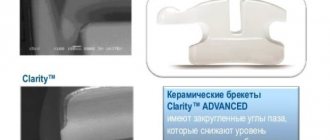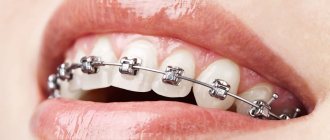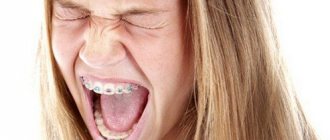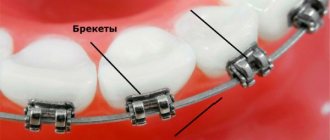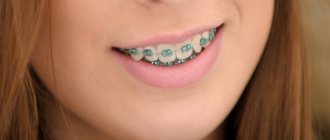In orthodontics, plates or braces are most often used to correct bite pathologies. These two types of structures successfully cope with the task assigned to them, but they are very different from each other in type, purpose, price, etc. Therefore, many patients are concerned with the question, which is better to use for braces or plates to correct the bite? Only through comparison will each patient be able to decide on the choice of the system that is suitable for him.
What is the difference between the design of plates and braces?
Plates and braces are equally often used in pediatric orthodontics to correct bites and correct dentition.
They have significant design differences:
- Plate structures are a removable device for the correction of teeth occlusion disorders. Designed to correct minor malocclusions. They align separately located units well with each other. The devices cannot apply significant pressure to the jaw and teeth. Systems can only hold units and prevent them from bending. They can activate or inhibit jaw growth. These designs are worn for several hours during the day. It is possible to remove them from the oral cavity and install them yourself. They are removed during meals for hygiene purposes.
- Braces are a reliable orthodontic system and are non-removable structures. It cannot be removed by the patient himself. She copes with the correction of the most complex dental defects. The process of straightening teeth with systems is quite lengthy. It lasts up to several years, so a certain psychological attitude is required from the patient. The design consists of locks that are tightly attached to the teeth using special glue. They are fastened with a metal arch, which exerts significant pressure on the dental units and alveolar processes.
Only the orthodontist decides which design to choose for the patient to correct closure anomalies.
Materials and manufacturing technology, differences
The plates are made in a dental laboratory individually for each patient using pre-made impressions. They are installed on the lingual side of the dentition. These are removable structures that, if necessary, can be easily removed by the patient from the oral cavity independently (before eating and before brushing teeth). Also, the system can be removed if you have to attend an important event.
The plates are made of special plastic (usually acrylic polymer). Individual parts can be metal (springs, bows, clasps, screws and other elements). The finished product completely follows the relief of the gums and palate and fits tightly to them.
Braces systems are non-removable structures designed for constant wear. With their help, even advanced dental pathologies can be cured. Depending on the type, they are installed both on the outside of the teeth and on the inside (lingual). Before starting treatment, the oral cavity must be sanitized. During installation, the tooth enamel is polished and a special glue is applied to which the clasps are attached. Therefore, you will not be able to remove the structure yourself. Locks are attached to each tooth to secure it in place. A metal arch is inserted into the groove, the force of which causes the teeth to move to a new correct position. Correction is often accompanied by painful sensations.
Various materials are used to make braces: metals, ceramics, sapphires, plastic. You can choose the most suitable option for yourself.
Differences in mechanism of action
Correction devices differ in their mechanism of action. Plate designs have one or more screws. They allow the growing jaw to expand, making room for permanent teeth. Metal arches correspond to the correct position of units in the dentition. The device cannot have a significant effect on the jaw. She cannot move dental units over a significant distance. It is used when there is no need to move it over long distances. It copes well with tilting and turning individual units. It is also used in young children to prevent malocclusion or to change the width of the growing palate.
Appliances for permanent wear have a wider range of possibilities for correcting malocclusion and dentition defects. The systems are able to place the tooth in the required place by pulling it out of the alveolus. Braces can immerse it deeper into the jaw, tilt it in the required direction, or rotate it relative to its axis. Unlike removable appliances, they are capable of correcting serious disorders of the dental system, and not just preventing them.
At what age can you get braces?
Braces can be installed at absolutely any age. Not only for teenagers and adults, but also for children. At the same time, they can be used to correct any type of bite. From the simplest situations to the more complex.
A teenager will have to wear braces for a long time. From six months to two years. Interestingly, the treatment of children’s teeth is faster than that of adults. Therefore, if you notice problems with a teenager’s teeth, contact the clinic immediately. And install braces. It is much easier to correct a teenager's bite in childhood.
Differences in indications for installation
Indications for the installation of both devices are violation of jaw closure, curvature of the dentition, displacement of individual dental units. However, they may differ in a number of parameters.
Indications for installing permanent structures:
- single defects of dental units;
- several crooked adjacent incisors;
- large gaps;
- anterior displacement of the incisors;
- various types of closure defects;
- impaired diction associated with malocclusion;
- deformations of the facial skeleton;
- crowding.
Indications for the installation of systems are severe pathologies of the dentofacial system, including in a fully formed jaw.
Indications for correction of anomalies with plates are as follows:
- beginning movement of teeth in the wrong direction;
- high probability of displacement of dental units;
- signs of initial jaw deformation;
- symptoms of pathological changes in the width of the palate.
Indications for the use of corrective plate devices are mild, incipient manifestations of pathology.
Under what conditions should braces be installed?
Braces should be installed if:
- A teenager has problems with his jaw. And also with its development.
- The teenager's front teeth had shifted significantly. And they looked sideways.
- The teenager's profile was deformed. And the face began to have incorrect proportions. Due to crooked teeth.
- The molars began to develop incorrectly. Not in accordance with prescribed standards.
- Some teenagers' teeth are too long. And others are too short.
Braces prevent your teenager from continuing to develop a malocclusion. They can modify irregularities found on a teenager's teeth. And bring them to the right state. Make sure your teeth are healthy.
When you take your teenager to the dentist, be sure to listen to his recommendations. If he advises a teenager to use braces, then install them. If it’s a record, then give preference to it. The specialist has a better idea of which treatment method will be more effective for the teenager.
Differences in age indications
The difference between a plate and braces is that they are used in different age groups of patients. Permanent systems are widely used only from the age of 12, when the jaw is already fully formed and all teeth have erupted. From the age of 14, adolescents can have lingual devices installed, this is explained by the difficulty of caring for them. Sometimes special fixed devices are installed starting from the age of seven. If they have severe bite defects that cannot be corrected later.
Plates are installed for children aged six to twelve years, during the replacement of the primary bite with a permanent one and the formation of the jaw bones. In adults, they are less effective, since a significant effect on formed bone structures is required. They use removable devices after treatment with permanent systems.
Prices
Installing a record will cost very little - about 3-5 thousand rubles. But braces will cost much more. The cost of treatment depends on their type. Metal systems are considered the most budget option. The average price is 40-100 thousand rubles. Sapphire systems cost about 90-180 thousand rubles, and ceramic ones - 60-140 thousand rubles.
Plates and braces are two different treatment methods, each of which has its own specific effects. The final decision on the advisability of using a particular design in a patient is made by the orthodontist.
Pros and cons of orthodontic structures
Let's look at the positive and negative qualities of the two methods of bite correction.
Pros and cons of permanent devices
They have their pros and cons as any method of bite correction.
Braces for children have the following advantages:
- provide rapid correction of anomalies due to continuous, powerful impact;
- corrects complex, congenital defects;
- wide range of application by age;
- easy adaptation;
- do not provoke problems with diction;
- quick repair possible;
- the ability to move dental units in the desired direction.
These devices not only have advantages, they also have disadvantages.
These include:
- low aesthetics of metal devices;
- difficulties in caring for them;
- high price.
Despite the inconvenience of correction systems and other disadvantages, it is widely used among adolescents.
Price difference
Braces and plates have a fairly large difference in price, which also often affects the patient’s choice. Braces price:
- Sapphire systems – 85–175 thousand rubles.
- Metal systems – 36–107 thousand rubles.
- Ceramic systems – 56–133 thousand rubles.
But the plates will cost from three thousand.
Summarizing the above, we can draw a conclusion. If the patient wants a system with good aesthetic indicators and the duration of treatment does not scare him, he can opt for plates. But it is worth remembering that these systems will not be able to solve serious problems with bite pathology. Braces are a more reliable option. They will be more expensive and less attractive, but the results of treatment will be visible from the first weeks of using the structure.
Sources used:
- Toledo SR, Oliveira ID, Okamoto OK, Zago MA, de Seixas Alves MT, Filho RJ, Macedo CR, Petrilli AS. "Bone disposition, bone resorption, and osteosarcoma." Orthopedic Research Society.
- Proffitt U.R., Modern orthodontics (3rd edition), MEDpress-inform, 2015, 560 p.
- Gerasimov S. N. Fixed orthodontic equipment. Publishing house. St. Petersburg State Medical University, 2002
Pros and cons of plates
They also have their advantages and disadvantages.
The advantages of this type of structure include:
- no labor-intensive care required;
- does not interfere with oral hygiene;
- removed for meals;
- atraumatic;
- easy adaptation;
- high efficiency in childhood;
- affordable price;
- are removed independently.
Orthodontic removable appliances have a few disadvantages.
These include:
- ineffectiveness of correction in adults;
- allergies are possible;
- severe anomalies are not corrected;
- fragility;
- If it breaks, it’s difficult to fix, you have to order a new one.
A number of positive qualities of plates for children ensure their widespread use in pediatric orthodontics.
Price difference
Permanent correction systems and measures for their installation and maintenance will cost the patient much more than corrective plates.
Here is the estimated cost of various types of structures per jaw:
- metal – 30,000 rubles;
- ceramic – 40,000 rubles;
- sapphire – 70 thousand rubles;
- sapphire with a white arc - 80,000 rubles;
- lingual – up to 100,000 rubles.
The cost of the structure itself is not the final price of the entire treatment. The price for all services for installation, activation of the device and its removal is separate. Various types of plate correctors cost from 20 to 50 thousand, depending on the model.
Choosing plates or braces is quite difficult for a non-specialist. The choice of a device for the correction of dentoalveolar anomalies is carried out only by an orthodontist, taking into account all the characteristics of the patient.
Differences due to system care
The plates are more maintenance-free. To carry out high-quality oral hygiene, it is enough to remove the structure. The whole procedure consists of the usual brushing of teeth and cleaning the plate itself. To carry out the procedure, you will need a toothbrush that has soft bristles and an antibacterial cleaning agent (paste).
There will be more problems with braces systems. The structure cannot be removed, which means the entire procedure must be carried out very carefully to avoid damage. To carry out high-quality hygiene you will need:
- Special brush.
- Gentle fluoride paste.
- Irrigator.
- Dental floss.
- Antibacterial rinse.
Additional cleaning of both structures must be carried out in dentistry. Typically this procedure is repeated every 6 months. The same deadlines are observed for assessing the quality of treatment and inspecting the system for damage.
The difference in a possible solution to a bite problem
The plastic plate does not exert intense pressure on the teeth, so it will not be able to cope with serious pathologies. It is permissible to use an orthodontic structure of this type in cases where the initial stages of the disorder or subtle bite defects are present. Plates are also used in the case of fixing dental units that have been previously aligned with braces (consolidating the result).
When are plates and braces installed?
They are used under different circumstances. It is better to put braces on people who have permanent teeth (children, teenagers, adults). Plates are usually used for uneven baby teeth or when they begin to change.
But there are cases when records are also played for an adult. This may be affected by the diagnosis and some reasons. But plates will not give the desired result in straightening permanent teeth, so it is better to choose braces.
Until what age is it recommended to have braces?
It is recommended to install braces until the age of twenty-five. Until this age, a person’s teeth are actively growing. And they develop. It is easier for children to correct them than for adults.
When a person reaches twenty-five years of age, this can lead to serious problems. The tissue may become very stiff. As a result, the teenager's jaw will be formed. And it will be very difficult to correct the bite. After putting on braces, a teenager will have to have his teeth treated for a very long time. You will have to wear braces for 24 months or more.
It is not recommended to get braces after twenty-five years of age. Because there is a risk that you will have to wear the plate for the rest of your life. To keep your teeth straight.
Types of braces
Braces are a complex system consisting of several small clasps that are firmly attached to the teeth. To install them, doctors use a special adhesive base that releases fluoride, which performs a protective function in relation to the enamel from the loss of mineral components.
Important ! Each bracket is attached to a separate tooth, since it initially contains information about the required position of the tooth in 3 dimensions.
Depending on the type of braces you choose, your smile will vary. Some prefer metal classic devices, others agree to correct their teeth only if the braces do not catch the eyes of those around them. For teenagers, installing braces is another way to emphasize their individuality, as the doctor can offer shaped or colored devices.
Modern dentistry uses several types of braces, which are produced in Russian cities and abroad. The vestibular and lingual apparatuses differ in location. The first ones are attached to the front part of the dentition, which makes them noticeable, but no less aesthetic. Their cost is a little less, the end result is more pleasing, and they do not require prolonged wear to correct the dentition. The latter are attached to the back of the teeth, making them invisible to people.
Important ! Various materials are used to make braces. Based on the recommendations of the orthodontist and the estimated budget, you can choose metal, sapphire, ceramic or composite structures.
The braces retainer can be direct or indirect. With direct bonding, braces are placed on each tooth. Indirect fixation is considered a faster method. To do this, a plaster model of the teeth is made, to which braces are attached, connected by aligners, as a result of which they are quickly and easily transferred to the patient’s dentition.
Until recently, doctors installed only classical devices, in which the ligature acted as a fixator. In modern medical institutions, non-ligature braces are used. They are held on the arch with a clip. This type allows you to quickly correct uneven teeth.
Non-standard types
Braces keep getting better. According to rumors, magnetic braces are being developed in Oxford laboratories. It is possible that in the near future they may begin to be sold on the medical products market. But for now, unusual varieties include curly, multi-colored and self-adjusting braces.
Self-adjusting bracket systems
Just recently, we could not imagine that teeth correction would be done independently. But braces with this function still appeared. They are made for each individual patient. Each element is customized to the position in which each tooth should be, and at the start of treatment you can already know what kind of smile the result will be.
Important ! Such braces reduce the risk of dental trauma and shorten the therapeutic course of treatment by a quarter.
Figured devices
When a specialist insists on ligature metal braces that have a lack of visibility, this problem can be solved with curly braces. They can be made in the shape of flowers, stars and hearts. These braces are especially popular among children and teenagers. They are also characterized by reliability, durability, and are also distinguished by their low price.
Colored braces
An equally original way to turn ordinary braces into a fashionable decoration is to install colored braces. They are cheap and allow you to experiment with your smile.
How to determine which is better
Plates are more suitable for children aged 5–7 years, whose temporary bite is replaced by a permanent one. Even kids can take care of retainers; they are easy to remove for meals and clean with a regular brush. The plates are inexpensive, but they do not correct serious deviations.
When wearing braces, which place constant pressure on the row:
- adaptation occurs quickly;
- the teeth will mix in the right direction;
- birth defects are eliminated;
- abnormal bite is corrected.
The answer to the question of which is better: a brace or a plate depends only on the real needs of the patient. You should consult your dentist to determine the right orthodontic system for you.
Expert opinion
Today, patients do not suffer from lack of information and can be aware of all treatment options. This is very good, since the orthodontist does not need to explain very clear things to each new patient. But this does not mean that you can completely entrust all questions to informative sources, based on them, self-medicate and select braces or plates for yourself. Of course, the doctor can take into account the patient’s opinion and wishes, but the dentist will make the final decision regarding the treatment method based on the exact results of the examination and the existing defects of the oral cavity.
Important! The aesthetic aspect should also not be overlooked. It is no less important, but we should not forget that we are talking mainly about health, and not just about beauty. The doctor, like the patient, should be primarily concerned about the effectiveness of treatment.
You should not look for ways to eliminate health problems and implement them yourself; it is better to seek help from an experienced and professional orthodontist. In this case, you can be completely confident in the quick and effective elimination of the problem, which will not bother you again in the future.
